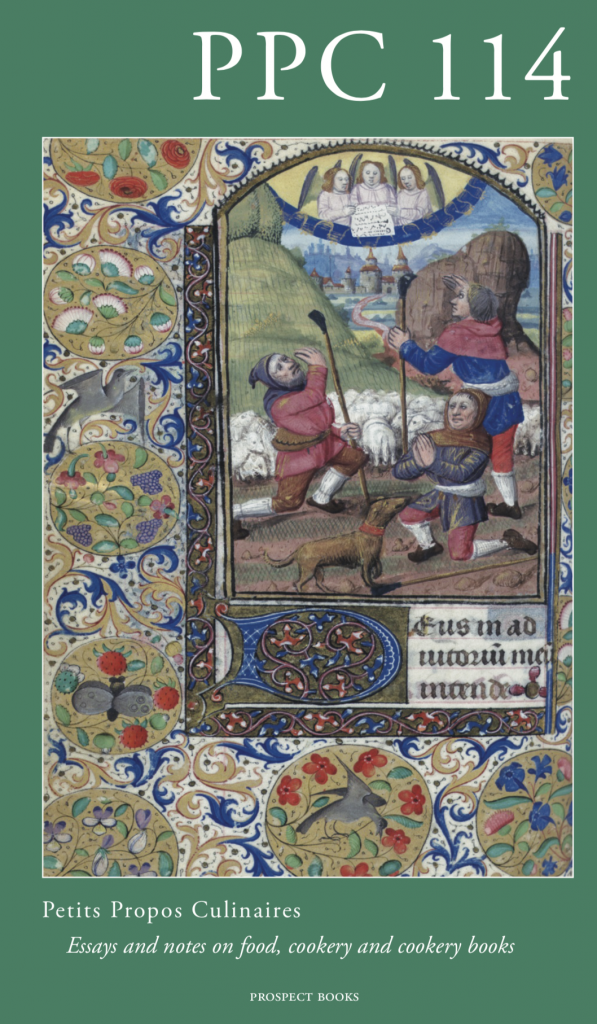Description
PPC 115 (October 2019).
Contents
‘Turnips that Cut Like Marmalade’
Bridget Ann Henisch
Brandy Snap: Reviving Historic Fairground Foods
Charles Spence, Carlos Chulia Sanchez, Jozef Youssef
Modern Recipes: a Case of Miscommunication
Peter Hertzmann
Gender, Intersectionality and Disease: the Consumption of Bat Meat in the Mount Cameroon Region
Efuet Simon Akem
Archestratus in Perspective: the Ingredients
Carmen Soares
The Egg in European Diet and What it Tells Us
A.R.T. Kemasang
Tracing the Original Owner of an Irish Manuscript Recipe
Book Malcolm Thick
The Hidden Lexical Lives of the Fool, Trifle and Gooseberry
William Sayers.
PPC 115 has everything from eggs to brandy snaps, trifle to bat meat. Here is an extract from an article on the consumption of bat meat in the Cameroons, where I imagine bats are not a protected species, as they are in a great deal of the Western world. Sadly, the article touches on the transmission of ebola, just as the aids virus HIV was traced back to the handling of chimpanzees, gorilla and bats.
Efuet Simon Akem
The hunting of bushmeat, the meat of wild animals, is an ancient practice and a common behaviour in rural African villages, particularly in forest areas. Bushmeat has long been a part of the staple diet of forest-dwelling peoples in Africa (Fa et al. 2000), but the hunting and eating of bushmeat by humans carries a substantial risk for cross-species transmission (Wolfe et al. 2005). Until recently, this interaction and relationship has been considered an important source of wildlife infectious diseases transmissible to humans (Daszak P., Cunningham A.A., Hyatt A.D. 2001; Kilpatrick A. M., et al. 2006a).
Several very important zoonoses (diseases which can be trans- mitted to humans from animals) have emerged or re-emerged from wildlife species. For instance, HIV is alleged to have been transferred from primates to humans, probably during hunting (Barre-Sinoussi 1996); Ebola outbreaks have resulted from the handling of the carcasses of gorilla, chimpanzee or bats (LeRoy et al. 2004); and Severe Acute Respiratory Syndrome (SARS) is said to have originated from small wild carnivores (Peiris et al. 2004). According to the World Health Organization (WHO 2014), ‘Ebola is introduced into the human population through close contact with the blood, secretions, organs or other bodily fluids of infected animals.’ Fruit bats and other wildlife, especially non-human primates, are considered to be the natural host of the virus. Accordingly, the emergence of disease is the result of an interaction of social, demographic, and environmental changes in a global ecology and in the adaptation and genetics of the microbe, influenced by international commerce and travel, technological change, breakdown of public health measures, and microbial adaptation (Learmonth 1988, Wolfe et al. 2005, Jones et al. 2008, Hayman et al. 2010). In the southern forest of Cameroon, like in most tropical forests in sub-Saharan Africa, the building of roads provides access to wildlife and is often associated with increased demand for, and access to, bushmeat. This process is thought to have led to spillover of zoonotic viruses such as simian immunodeficiency viruses and the emergence of HIV-1 and -2 (Hahn et al. 2000). Ebola haemorrhagic fever (EHF) virus outbreaks in humans have repeatedly been linked to the handling of infected great apes (Leroy et al. 2004). With the expansion of human populations, there has been an increase in demand for bushmeat, particularly in locations where alternative sources of protein have been scarce (Bulte and Horan 2002; de Merode et al. 2004; Fa et al. 2000). It is therefore likely that the risk of future disease emergence through this process will also increase (Daszak P., Cunningham A.A., Hyatt A.D. 2001).
The first reported outbreaks of the Ebola virus emerged in 1976 in the Democratic Republic of Congo (DRC) and Sudan in June and September respectively. It was however established that the two outbreaks were caused by two species named Zaire ebolavirus (ZEBOV) and Sudan ebolavirus (SEBOV) which were antigenically and biologically distinct (Muyembe et al. 2012). The outbreaks in Sudan and DRC in 1976 recorded 53% (151/284) and 88% (280/318) mortality rates respectively (WHO 2014). Again in 1979, a small outbreak emerged in Nzara and Maridi, both in Sudan, with a mortality rate of 64% (22/34). After a break of 13 years in the infection, EHF re-emerged and this time spread to other parts of Africa. An outbreak was reported in Côte d’Ivoire in 1994 and was believed to have originated from a chimpanzee. This outbreak was caused by a different species of Ebola virus which was named Côte d’Ivoire ebolavirus (Le Guenno et al. 1995). This was followed by the outbreaks in Gabon in 1994, 1996, 1997 and 2001–2002 which were caused by the Zaire ebolavirus (ZEBOV). These outbreaks were associated with infection from the handling of a sick gorilla killed during hunting (Georges-Courbot et al. 1997a, b; Leroy et al. 2002). Other EHF outbreaks were ZEBOV that occurred in the DRC in 1995 with 79.4% (250/315) mortality rate (Khan et al. 1999), and those that were reported in 2007 and 2008 in the DRC with mortality rates of 70.0% (187/264) and 43.8% (14/32) respectively (Leroy et al. 2011; Muyembe et al. 2012). Further outbreaks were reported in Uganda in 2000 and 2007 with mortality rates of 52% (224/425), and 26% (30/116) respectively (Lamunu et al. 2004; Towner et al. 2008). An isolated case of EHF caused by SEBOV was reported in Uganda in 2011 (WHO 2011). Another outbreak with mortality rate of 41.2% (7/17) was reported in Sudan in 2004 (Onyango et al. 2007). In August 2014, the WHO confirmed a separate outbreak of Ebola in the DRC. However, this outbreak was a different strain of the virus and unrelated to the epidemic in West Africa, which now dwarfs all that had come before. Figures up to 13 January 2016 put total deaths at 11,315 (WHO 2016). But on 13 January, 2016, the World Health Organization declared the last of the countries affected, Liberia, to be Ebola-free. The World Health Organization said Ebola virus disease has a fatality rate of up to 90% and that the virus is transmitted to people from wild animals and then spread from human to human.



